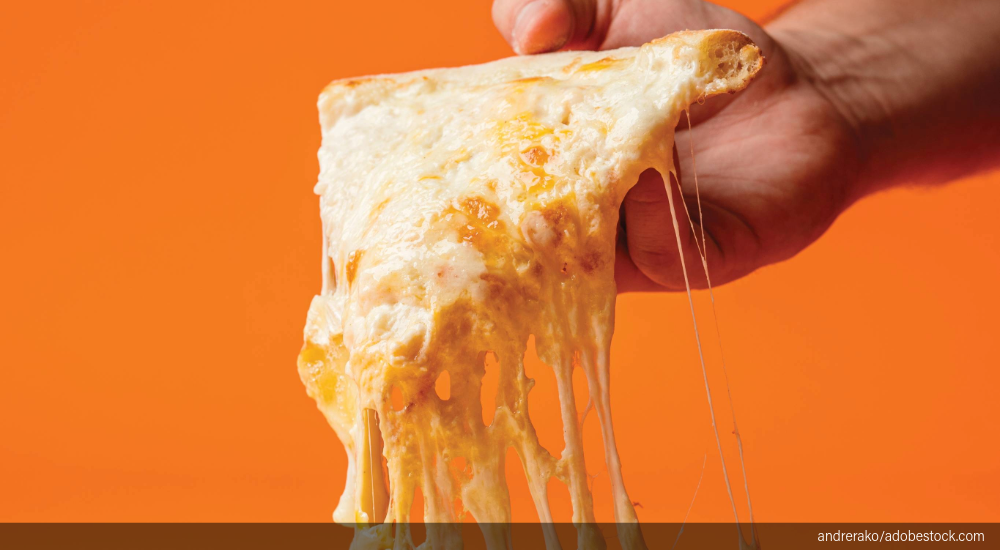Cheese prices can keep a pizzeria operator up at night. Any veteran operator has seen the fluctuations in cheese prices and how they impact pizzerias’ costs and menu prices. Tracking the cheese market can help you navigate the volatile fluctuations in cheese prices.
A Quick Cheese Price Primer
Cheese prices are set on the Chicago Mercantile Exchange (CME) using block cheddar as the industry standard and barometer for pricing other natural cheese varieties in the U.S. We went straight to the source for the 411 on cheese prices. Dick Groves is editor at The Cheese Reporter, a publication and online resource that has been serving the dairy industry since 1876.
“The cheese market prices are established at the Chicago Mercantile Exchange,” he says. “They hold a daily cash or spot market. It lasts just a few minutes every day, and companies that basically have excess supplies will offer cheese on the CME. Companies that need extra cheese will try to buy that on the CME. And that’s basically how prices are determined on a daily basis.”
Prices on the CME come from several factors, including basics of supply and demand and market volatility – influenced by factors such as government policies, international trade and natural disasters. “You can look at things like droughts, floods, winter storms, bird flu,” Groves says. “Last year was a pretty big impact, because it cut milk supply and some tea.”
What’s happening in the Cheese Market
To gain a better understanding of cheese prices, let’s explore what is happening overall in the cheese market. Major developments impacting the overall cheese market are:
• Block price under $2. The block prices on the CME haven’t surpassed $2 this year. That’s good for pizzerias, Groves says, but “that’s the exception rather than the rule, I think, in recent years.” This year, block cheese price saw its peak in February at $1.8845 and its lowest in March at $1.6438. September saw an average of $1.6670.
• Cheese exports are high. Cheese exports hit record levels in June and July, with over 110 million pounds exported, Groves notes. “And when that kind of demand hits the market – it hasn’t really increased the price because cheese prices aren’t that high right now – but it kept prices from going down more than they otherwise would.”
• New cheese-production facilities have come online. Mike Brown, vice president of dairy market intelligence at T.C. Jacoby, is monitoring the increased production closely. “The big news in cheese is that, in the past couple years, we’ve had a couple of big plants in the cheddar business,” he says, which has increased capacity on the cheddar side.
• Foodservice is down. While pizza continues to drive the foodservice cheese market, the foodservice cheese market in general is down, which is expected amid economic instability. “As long as people are uncertain on the economy, they’re going to be a little more frugal how they purchase,” Brown says. As families cut expenses, dining out becomes less frequent, especially at mid-tier and more expensive restaurants.
• Growth in retail. While foodservice numbers lag, retail cheese markets are flourishing. Madlyn Daley is senior vice president, strategic intelligence, with Dairy Management Inc. She’s tracking some interesting insights in the consumer market. “Year to date, it’s nearly two-percent growth, and that’s in volume,” she says. “The top cheese varieties – which are like cheddar, cream cheese and mozzarella – all three of those were still growing.” With the retail market thriving, look to consumers for new cheeses to introduce on your menu. Hispanic cheeses, grilling cheese and cheese blends (see page 32) all are rising in popularity.
What to watch for
While pizzeria operators can’t be expected to be full-time dairy market analysts, there are some key price influences that pizzerias should be aware of. A few of those include:
• The FDA Food Traceability Rule. The requirement has been delayed until 2028. The rule would require additional traceability recordkeeping requirements (beyond what is already required in existing regulations) for persons who manufacture, process, pack or hold foods on the Food Traceability List, including cheese (made from pasteurized milk), soft ripened or semi-soft and cheese (made from unpasteurized milk) other than hard cheese. “It will affect the majority of cheese produced in this country,” Groves admits. “It affects everything but hard cheeses.” New software and systems will need to be in place to comply with the new rule.
• Tariff uncertainty. Thus far, the cheese market hasn’t seen the impact of tariffs, like the soy market. Groves points to cheese-making equipment as an area to watch, particularly steel imported from the European Union. “There’s a lot of uncertainty surrounding where the tariffs are headed and what the retaliatory tariffs are going to look like,” Groves says.
• Look for butter fat and whey shifts. Higher butter fat levels have supported strong butter prices, which in turn influence the dairy market, including cheese prices. “The way the formula works, when the fat price goes down, the regulated milk protein price goes up,” Brown says.
• Whey is another area to look to. Brown notes that whey protein, particularly whey protein isolate (WPI), is in extremely high demand.
What can you do
Continual shifts in cheese pricing can make it difficult to know how to negotiate with your supplier, control portions in your kitchen and price items on your menu. There are steps you can take to have a better handle on your end-result cheese prices. They include:
- Follow the Block Cheese Market. See the daily and weekly averages of cheese prices on the CME at The Cheese Reporter, cheesereporter.com.
- “Expect the unexpected,” Groves says. “The only certainty is uncertainty. The only predictability is unpredictability. If there’s a way to lock in prices with your cheese provider, now is probably a pretty good time to do it, because I don’t think prices over the long haul will be this low for that long.”
- Lean on pizza industry thought leaders. We’ve pulled together an “Understanding Cheese Prices Guide,” with tips from pizza industry veterans at PizzaToday.com.
- Consider a single vendor contract for cheese purchasing. Talk to your vendor about a cost-plus contract to stabilize your cheese prices.
- Switch to block? If you use pre-shredded, run the numbers on switching to block cheese and shredding it in house. Don’t forget to factor in equipment and labor.
Other best practices include portioning your cheese on every application. Keep a keen eye on your inventory controls for fluctuations. Review menu prices quarterly for major shifts in pricing.
Denise Greer is Editor-in-Chief at Pizza Today.
 Read the November 2025 Issue of Pizza Today Magazine
Read the November 2025 Issue of Pizza Today Magazine
This month, we are diving deep on all things cheese. Learn how the fluctuating commodities market can impact the price you pay for mozzarella and other block cheeses. Then, find out how operators are using craft beer cheddar, gorgonzola and plant-based cheeses made from cashews, coconuts, peas and other bases to create pizzas that are visually and gastronomically stunning. Round out your education for the month by brushing up on pizzeria art, SOPs and winter squash.
Check out the full Digital Edition – Pizza Today November 2025.



